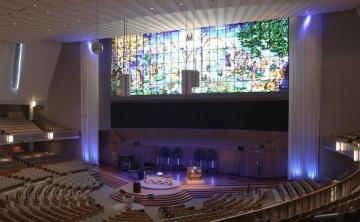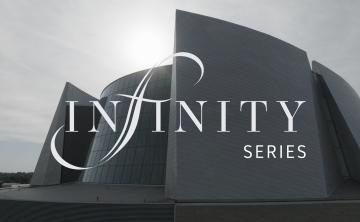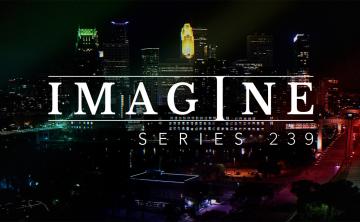Rodgers Spotlight: The First Ten Years

Our Spotlight for this issue of “65 Stories Celebrating 65 Years” features a reprint of a 1968 internal Rodgers company publication celebrating the first 10 years at Rodgers – loaded with historical firsts!


The text from the above reprint is duplicated here for easier reading:
Ten years ago, on April 30th, 1958, a giant step was taken towards the realization of a dream – to produce electronically a tonal diversification found before only in the best pipe organs.
On that day, Rodgers Organ Company was incorporated by Rodgers W. Jenkins (President), Fred B. Tinker (Vice-President and Chief Engineer), and Don Ellis. Directors and private stock holders were Howard Vollum and Jack Murdock. Joan Jenkins and Bill Johnson were the first two members on the staff of employees.
The infant company set up its first manufacturing facilities at 10400 SW Canyon Road, in Beaverton, Oregon. Shortly afterwards, the first Rodgers prototype was brought into existence. It was affectionately dubbed “The Purple Beast,” the first of an exciting new generation of quality organs.
Rodgers’ first production instrument was the Model 38, which incorporated the most advanced of organ design concepts. It had 550 tone generators, individually voiced and tuned, and was completely transistorized. It was built to A.G.O. specifications. The Model 38 was quickly accepted as a major contribution to the classical organ field. It was first presented to the public at the inauguration of Oregon Governor Mark Hatfield, on January 12, 1959. It was played by Charles O. Gray, A.A.G.O., organist for the 6th Church of Christ Scientist in Portland. The organ was later installed at Lewis and Clark College, Portland, Oregon, where it served as the company’s demonstrator until the college decided to buy it for their own private use, one year later.
Rodgers’ first dealer sale was to Leathurby and Company, of San Francisco, the first dealership established by the company. Other dealerships were soon established in Portland, Philadelphia, Pittsburgh, and Tacoma … and sales began to multiply!
The initial success of the new Rodgers organ created an urgent need for larger quarters, and ground was broken in Hillsboro for a brand-new building. It was occupied in June, 1960, by a personnel force which had by that time expanded to 12 employees. At that time, Rodgers Organ Company “might” some day employ up to 40 people! The new factory was less than a quarter of its present size.
Things began to move at an even faster pace and as the company intensified its research and development efforts, many other industry “firsts” made their appearance, besides the production of the first completely-transistorized A.G.O. organ console. Notable among these was the introduction of the first transistorized amplifier suitable for the amplification of organ tones, the use of drawknobs as standard items on certain Rodgers models, a “computerized” capture system, and the use of Space-Age components such as the reliable reed switch for pedal switching.
About the time of the National Association of Music Merchants Trade Show, in July, 1961, Rodgers added to the line their first two-manual church console, the Model 24A. It, and the Model 22-E – a two-manual horseshoe theater organ – both completely transistorized instruments of the highest quality, were shown at that show as the company’s first Industry showing. More dealerships were added.
1962 saw the introduction of the three-manual horseshoe theater organ, the Model 34-E. Its Wurlitzer theater-like voices were expressed through the world’s first all-transistorized organ amplifier, the TA-50.
The company’s first church installation was made in the First EUB church in Eugene, Oregon. That was in 1959, barely one year after incorporation. The first Rodgers custom drawknob organ installation was made at Richland, Washington, in the Central United Protestant Church. The design and installation of this magnificent instrument was personally supervised by Rodgers’ Tonal Director, Bill Anderson.
In December of 1960, Rodgers installed a large custom organ in Portland’s Memorial Coliseum. This instrument produces thrilling, dramatic Theater Organ sound and also incorporated classic voices to enhance its versatility as an all-purpose instrument. Its thunderous voices are beamed to all corners of the large coliseum by a specially-built speaker system that contains no fewer than 94 individual loudspeakers, in 32 separate speaker enclosures.
Don Baker, nationally-known organist who was then associated with Rodgers Organ Company, played at the dedication ceremonies. Soon afterwards, Don played the Memorial Coliseum Rodgers – then billed as the “World’s Largest Electronic Organ” – for the Capitol recording, “Sound of 94 Speakers.”
The years 1963, 1966, and 1967 saw the further addition of factory space to provide a larger cabinet shop, electronics area and warehouse facility. The Rodgers factory now totals close to 50 thousand square feet – every square inch utilized to perpetuate the company’s well-earned position as the World’s Largest Builder of 3-Manual Organs.
In 1964, the 32-B was introduced. This advanced instrument included many features previously found only on larger, more costly organs, such as chiff and celeste … and it sold for under $10,000! That year also saw the appearance of the first Rodgers TRIO – a three-manual Theater Organ for the home that also sold for well under $10,000 (in fact, far less than half that!). The success of these instruments was such that improved versions still form part of the company’s standard line.
Rodgers made history in 1966 when it offered a drawknob console in the moderate price range. Drawknobs were not previously available on any organ console under $25,000. The Rodgers drawknob is an extremely reliable device that incorporates an ingenious magnetic mechanism that requires no moving parts. Today, the Model 22-B, equipped with 33 Drawknobs, plus Setterboard, Harp, Carillon, Celeste, and Air Sound, sells for under $10,000!!
Last year, engineering was completed on the Computer Capture Combination Action – a system that prevails upon computer technology to permit the condensing of a room full of clacking, mechanical relays into less than one cubic foot of space within the Rodgers console.
Rodgers has consistently pioneered in the field of Organ Technology and has been quick to avail itself of the use of many highly-reliable state-of-the-art magnetically operated components such as the Switch, mentioned before. This tiny, glass-enclosed switch will turn on and off a half-billion times without malfunctioning. This year will witness the introduction of an entirely new concept in Tracker touch – already judged to be a highly authentic duplication of the true feel of the old pipe-organ keyboard. And the TA-50 organ amplifier, for years the workhorse of Rodgers Organ Company, was replaced by the new S-100 – the finest unit on the market today.
Outstanding among the many achievements of Rodgers Organ Company are the magnificent Custom Installations that are appearing in ever-increasing numbers all over the country. Notable among these are the beautiful consoles installed in the First Christian Church, Wichita Falls, Texas … Fanwood Presbyterian Church, Fanwood, New Jersey … Central United Protestant Church, Richland, Washington, St. Mary’s Cathedral, Portland, Oregon, Church of the Holy Trinity, New York … Westminster United Church, St. Catharines, Ontario, Canada … and many others.
Today, serious organists and music directors do not have to forego the classic tonal beauty of the great pipe organs. The full-throated, majestic tonal versatility of the King of Instruments has been authentically duplicated in the Rodgers Organ. The all-embracing dispersion of hundreds of voices speaking from huge chambers and reverberating in large auditoriums is a proud accomplishment of Rodgers. Hundreds of churches, coliseums and halls across the nation resound to the inspiring, stirring tones of the thundering Reeds, the soft ensemble of vibrant Strings, and great Flutes … and the source of these traditional pipe-organ sounds today is more than likely to be one of the most remarkable musical instruments in existence today – the RODGERS!




